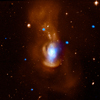CXC Home | Search | Help | Image Use Policy | Latest Images | Privacy | Accessibility | Glossary | Q&A
Tour of Medusa
Quicktime MPEG
NGC 4194 is a galaxy that is found about 110 million light years from Earth. This image of NGC 4194, also known as the Medusa galaxy, is a composite of X-rays from Chandra, seen in blue, and optical light data from Hubble, which are colored orange. Located above the center of the galaxy, the "hair" of Medusa is a tidal tail formed by a collision between galaxies. The bright X-ray source found on the left side of Medusa's hair is a black hole. A recent study of the Medusa galaxy and nine other galaxies measured the connection between the formation of stars and the production of so-called X-ray binaries. These systems, which contain either a black hole or a neutron star in orbit around a normal star, appear as the bright blue point-like sources in this image of Medusa.
[Runtime: 00:54]
Quicktime MPEG
NGC 4194 is a galaxy that is found about 110 million light years from Earth. This image of NGC 4194, also known as the Medusa galaxy, is a composite of X-rays from Chandra, seen in blue, and optical light data from Hubble, which are colored orange. Located above the center of the galaxy, the "hair" of Medusa is a tidal tail formed by a collision between galaxies. The bright X-ray source found on the left side of Medusa's hair is a black hole. A recent study of the Medusa galaxy and nine other galaxies measured the connection between the formation of stars and the production of so-called X-ray binaries. These systems, which contain either a black hole or a neutron star in orbit around a normal star, appear as the bright blue point-like sources in this image of Medusa.
[Runtime: 00:54]
(Credit: X-ray: NASA/CXC/Univ of Iowa/P.Kaaret et al.; Optical: NASA/ESA/STScI/Univ of Iowa/P.Kaaret et al.)
Return to NGC 4194 (March 11, 2009)



